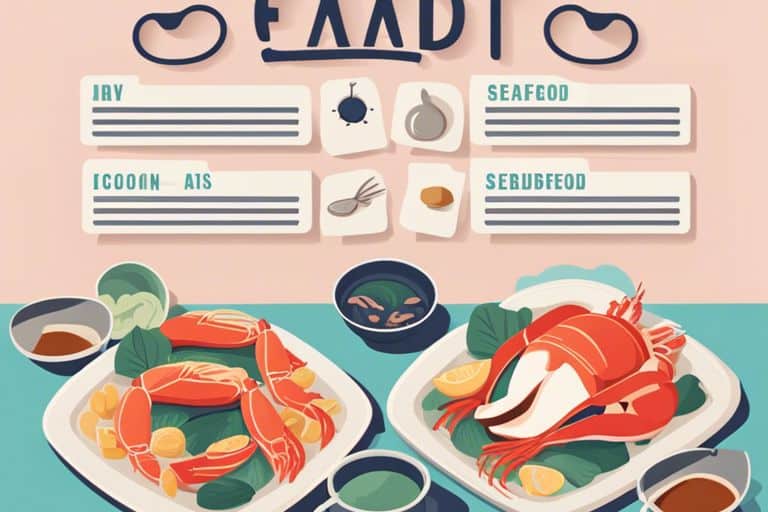You love seafood and need to create delicious dishes at home, however cooking seafood can be a bit tricky if you’re no longer acquainted with the dos and don’ts of handling those sensitive elements. In this blog submit, you may learn the vital guidelines and tips to follow while making ready seafood to make certain that your dishes turn out perfectly every time. From selecting the most up to date substances to getting to know cooking strategies, we’ve were given you protected with all of the dos and don’ts you want to recognize to grow to be a seafood cooking seasoned.
1. Choose fresh seafood for best flavor and quality.
2. Avoid overcooking seafood to prevent dryness and toughness.
3. Use high heat for quick and even cooking.
4. Season seafood dishes lightly to enhance natural flavors.
5. Experiment with different cooking methods like grilling and baking.
6. Follow recipes closely to ensure proper cooking times.
Selecting Quality Seafood
Freshness Indicators
Excellent seafood ought to show off particular freshness indicators. Search for clear, shiny eyes, vivid pores and skin, and a slight ocean scent. Gills ought to be purple or crimson for fish, and translucent for shellfish. Moreover, urgent the flesh have to depart an indentation that bounces lower back quickly, indicating freshness.
Understanding Seafood Varieties and Seasons
Expertise the one-of-a-kind forms of seafood and their seasons is essential for selecting the excellent high-quality. Sure fish like salmon are satisfactory loved in the summer months when they’re in season, at the same time as others like halibut are more abundant inside the winter. Knowing these nuances will make certain you pick out the hottest and maximum flavorful alternatives on your dish.
Freshness
Seafood sorts have unique peak seasons due to elements like migration styles and reproduction cycles. It’s important to bear in mind those factors while selecting seafood to assure you get the nice first-class and flavor. Stay informed approximately the optimal seasons for extraordinary varieties of seafood to make the maximum of your culinary creations.
Preparation Essentials
Proper Cleaning and Storage
Now, when it comes to preparing seafood dishes, one of the most crucial steps is proper cleaning and storage of the fresh seafood. Before you start cooking, make sure to thoroughly clean and rinse the seafood under cold water to remove any debris or bacteria.
Pre-Cooking Treatments
For optimal results, it’s important to properly treat the seafood before cooking. This could include marinating, brining, or even seasoning with herbs and spices to enhance the flavor profile of the dish.
PreCooking treatments like marinating can not only add flavor but also help tenderize the seafood, particularly tougher cuts like octopus or calamari. Brining is a great method to ensure the seafood remains moist and flavorful during the cooking process, especially for delicate fish fillets.
The Cooking Process
Temperature and Timing
To ensure your seafood dish turns out perfectly, it’s crucial to pay attention to the temperatures and timings during the cooking process. Refer to the table below for a quick guide on the ideal temperatures and cooking times based on the type of seafood you are preparing:
| Seafood Type | Ideal Temperature and Cooking Time |
| Shrimp | Grill at 400°F for 2-3 minutes per side |
| Salmon | Bake at 375°F for 15-20 minutes |
| Mussels | Steam for 5-7 minutes |
| Scallops | Sauté at medium-high heat for 2-3 minutes per side |
Methods: Grilling, Baking, Steaming, and Sautéing
To achieve delicious seafood dishes, mastering various cooking methods like grilling, baking, steaming, and sautéing is crucial. Each method offers unique flavors and textures to your seafood creations. Experiment with grilling for a smoky char, baking for a tender finish, steaming for a light and healthy option, or sautéing for a quick and flavorful outcome. Choose the method that best suits the type of seafood you are preparing to elevate its natural taste.
Understanding the different cooking methods for seafood dishes allows you to tailor your approach based on the type of seafood and desired outcome. Whether you prefer the charred marks from grilling, the flaky texture from baking, the delicate flavors from steaming, or the caramelization from sautéing, each method brings out the best in your seafood. By understanding the nuances of these techniques, you can cook seafood dishes with confidence and precision.
Flavor Enhancement and Pairings
Seasoning Dos and Don’ts
Not all seasonings are created equal when it comes to enhancing the flavors of seafood dishes. While herbs like dill, parsley, and chives can complement the delicate taste of seafood, strong spices like cumin or chili powder can overpower it. It’s important to strike a balance and use seasonings that enhance, rather than mask, the natural flavors of the seafood.
Complementing Seafood with Side Dishes
Enhancement Complementing your seafood dish with the right side dishes can elevate the overall dining experience. Light and fresh sides like steamed vegetables, citrus-infused salads, or herb-roasted potatoes can complement the flavors of seafood without overwhelming them. Avoid heavy or rich sides that may compete with the seafood’s delicate taste.
With these tips in mind, you can confidently pair and enhance the flavors of your seafood dishes with complementary seasonings and side dishes, creating a perfectly balanced and delicious meal every time.
Presentation and Serving
Plating Techniques
Serving a beautifully arranged seafood dish can elevate the dining experience. Consider the aesthetics of the plate and use techniques like layering, stacking, and garnishing to make the dish visually appealing. Keep in mind, people eat with their eyes first, so take the time to plate with care.
Appropriate Serving Utensils
Any seasoned chef knows the importance of using the right utensils when serving seafood. Opt for tools like fish spatulas, seafood forks, and shell crackers to ensure that your diners can enjoy their meal without struggling with tough shells or delicate fillets. These utensils not only make eating easier but also showcase your attention to detail.
It is crucial to have a variety of seafood-specific serving utensils in your kitchen to cater to different types of dishes. For example, lobster crackers are crucial for cracking open lobster shells, while fish spatulas are perfect for delicate fillets that need to be handled gently. Investing in a few quality utensils can make a significant difference in the presentation and overall dining experience of your seafood dishes.
Common Mistakes to Avoid
Overcooking Seafood
Mistakes happen, but one common error to watch out for when cooking seafood is overcooking. Overcooked seafood can result in a dry, tough texture and loss of flavor. It’s crucial to follow recommended cooking times and temperatures for different types of seafood to ensure a perfectly cooked dish.
Cross-Contamination Concerns
Concerns about cross-contamination are vital to keep in mind when preparing seafood dishes. To prevent the spread of harmful bacteria, it’s crucial to use separate cutting boards, utensils, and preparation areas for seafood to avoid contaminating other ingredients. Always wash your hands thoroughly with soap and water after handling raw seafood.
Seafood, including fish, shrimp, and shellfish, is highly perishable and can carry bacteria that can cause foodborne illnesses if not handled properly. By practicing safe food handling techniques and maintaining a clean cooking environment, you can enjoy delicious seafood dishes without the risk of cross-contamination.
Final Words
With this in mind, mastering the dos and don’ts of cooking seafood dishes will elevate your culinary skills and ensure that your dishes are not only delicious but also safe to eat. By following these guidelines, you can confidently prepare a variety of seafood recipes with the assurance that they will turn out perfectly. Remember to always buy fresh seafood, avoid overcooking, and be mindful of proper seasoning and flavor combinations. Cooking seafood can be a rewarding experience when done right, so don’t be afraid to experiment and try new recipes to expand your cooking repertoire. Happy cooking!

